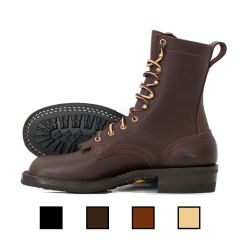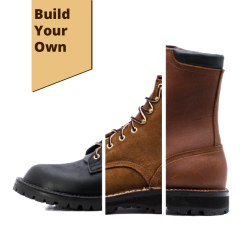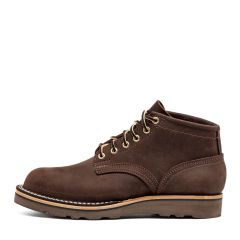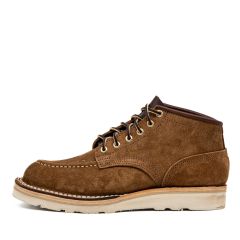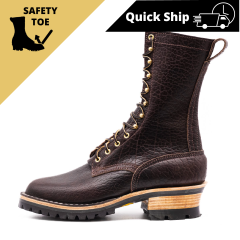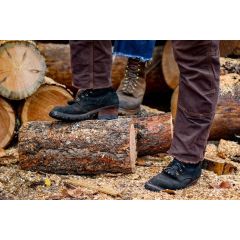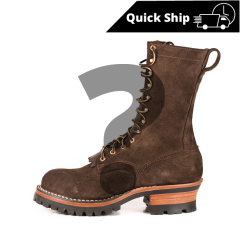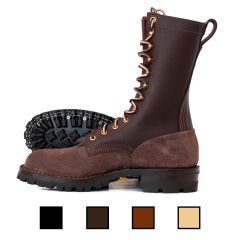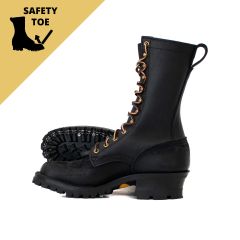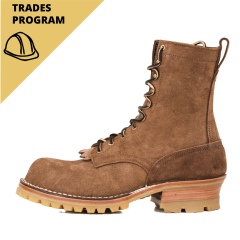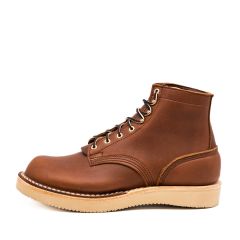High-Quality Work Boots
Why Full-Grain Leather Matters in Work Boots
A work boot is more than just a barrier between you and the ground. It should be a second skin—resilient, adaptable, and able to endure long hours without breaking down. Full-grain leather is the gold standard for serious work boots, offering unmatched strength, breathability, and the ability to mold to the wearer over time. Let’s cover why full-grain leather boots are superior in every way.
Unmatched Durability for the Hardest Jobs
Work environments are unpredictable, demanding, and relentless. For example, rough terrain, heavy tools, and exposure to the elements push boots to their limits. Full-grain leather holds firm where lesser materials fail, resisting abrasions, punctures, and premature wear.
A logger cutting through dense forest, a welder working near flying sparks, or a rancher moving across rocky ground—each one needs boots that can handle real-world punishment. While thin leathers and synthetic alternatives split, peel, or crumble, full-grain leather remains. Its dense fibers act as a shield, offering the protection needed to get through any job.
A Custom Fit That Only Gets Better with Time
A boot should work with your feet, not against them. Unlike the cheap alternatives, full-grain leather adapts to a wearer’s foot to create a fit that synthetic materials dream of doing. A lineman lacing up for a ten-hour shift needs boots that support without pinching. A carpenter moving between rough floors and ladders needs flexibility without losing stability. Full-grain leather provides both. The more it’s worn, the more it conforms, creating a fit that feels custom-made without losing structure.
Breathability That Keeps Feet Dry and Comfortable
Long shifts in non-breathable boots cause blisters, discomfort, and fatigue. However, full-grain leather allows air to circulate while keeping moisture at bay, striking the perfect balance between protection and ventilation. For example, a mechanic working in a sweltering shop or a construction worker laying asphalt under the sun doesn’t need a boot that traps heat. Unlike synthetic materials that suffocate the foot, full-grain leather wicks away moisture and regulates temperature, keeping feet cool in the heat and warm in the cold.
Built to Last, Aging with Character
A well-made boot isn’t something to be replaced after a year. It’s worn, repaired, and trusted for decades. Full-grain leather doesn’t just endure—it develops a unique patina, reflecting every mile walked and every job completed. An electrician who’s spent years in the same pair of boots will see the leather darken and smooth, each mark telling a story. While lesser materials crack and flake, full-grain leather gains depth and character. Instead of wearing out, it wears in, becoming a testament to the hard work of the person wearing it.
How Our Boots Support Skilled American Tradespeople
At Nick's Boots, we don’t just make boots. We craft reliable gear that tradespeople trust to carry them through the toughest workdays. Our commitment goes beyond the product itself. Every pair is a tribute to the men and women whose skill, resilience, and dedication keep industries running.
Who Relies on Nick's Boots?
- Lineman: Braving extreme weather and scaling towering poles requires unwavering grip, ankle support, and all-day stability.
- Loggers: Navigating dense forests and rugged landscapes demands puncture-resistant soles and tough leather that stands up to sharp debris.
- Construction Workers: Hours spent on concrete and shifting surfaces call for rugged soles that cushion impact and provide lasting support.
- Ranchers and Farmers: Long days in mud, dust, and unpredictable weather require water-resistant boots that breathe and stand up to the elements.
- Ironworkers: Balancing steel beams at dizzying heights means relying on slip-resistant soles and reinforced materials for maximum safety.
Nick’s Boots also supports hardworking professionals through the Nick’s Boots Trade Program, offering special pricing, free shipping, and expedited lead times on select models. We recognize the skill and dedication of electricians, plumbers, carpenters, and other tradespeople who keep the world moving. Every step taken in Nick's Boots is backed by craftsmanship, expertise, and the same determination that built this country.
Work Boots Configurations To Consider
The right configuration makes all the difference when choosing high-quality work boots. At Nick’s Boots, we build with purpose, ensuring every detail enhances durability, comfort, and performance for the jobs that demand them most.
Toe Structure and Style
The right toe structure provides protection and comfort based on the job at hand. Steel-toe boots, such as our BuilderPro Cutter’s Choice, are essential for construction workers and ironworkers who need impact resistance on busy job sites. With its roughout leather, solid brass hardware, and Vibram lug sole, this boot is built to handle harsh conditions while offering long-lasting durability.
Likewise, composite-toe options offer similar protection but are lighter, making them a solid choice for electricians and utility workers who require safety without added weight. Soft-toe boots allow maximum flexibility and comfort, ideal for ranchers, farmers, and tradespeople who prioritize movement over rigid protection.
Sole Construction
Sole stitching is an often-overlooked feature that plays a crucial role in the longevity and resilience of a boot. The right stitching can mean the difference between a boot that holds strong for years and one that starts to separate under heavy use. Standard stitching is sufficient for general laborers and ranchers who depend on their boots for everyday wear.
For those welders or foundry workers working in extreme heat, fire-resistant stitching prevents degradation from prolonged exposure to sparks and high temperatures. The 260-standard and 260-technora configurations provide extra durability, making them a smart choice for loggers, linemen, and industrial workers who operate in abrasive environments where traditional stitching might wear down more quickly.
Heel Profile
The right heel height determines stability, comfort, and posture support. With their raised profile, logger heels provide grip and security on uneven, sloped terrain, making them perfect for forestry workers. A lineman’s heel offers a defined edge for climbing, giving utility workers and arborists the extra support needed when scaling poles and trees.
A block heel, like the one featured in our Moc Toe Pro, provides a more balanced feel–perfect for carpenters and warehouse workers who spend long hours on flat surfaces. With its high water resistance and a design built for hiking, running, and kneeling, this boot ensures durability and flexibility for those who need reliable support without bulk. For those who require agility, a lower-profile heel ensures ease of movement while maintaining lasting performance.
Boot Height
Boot height plays a critical role in protection and mobility. Eight-inch boots provide extra ankle support and coverage, ideal for loggers and linemen who need stability while working in unpredictable environments.
Six-inch boots allow greater flexibility while still offering protection, making them a preferred choice for ranchers, farmers, and general laborers. Ten-inch and taller boots deliver maximum coverage for hazardous conditions, ensuring added security for those facing mud, brush, and deep terrain daily.
Outsole
The outsole is where the boot meets the ground, making it one of the most critical elements of work boot performance. Different jobs demand different levels of traction, flexibility, and shock absorption. Vibram outsoles provide superior grip on slick or uneven surfaces, making them a preferred choice for construction workers and utility crews working in wet conditions.
Oil-resistant outsoles are a must for mechanics and factory workers who frequently encounter slippery shop floors. Lightweight wedge outsoles reduce foot fatigue and provide stability, making them ideal for carpenters and warehouse workers who spend long hours on hard surfaces. In contrast, deep-lug outsoles give superior traction in muddy or rugged environments, making them the go-to choice for loggers and outdoor laborers.
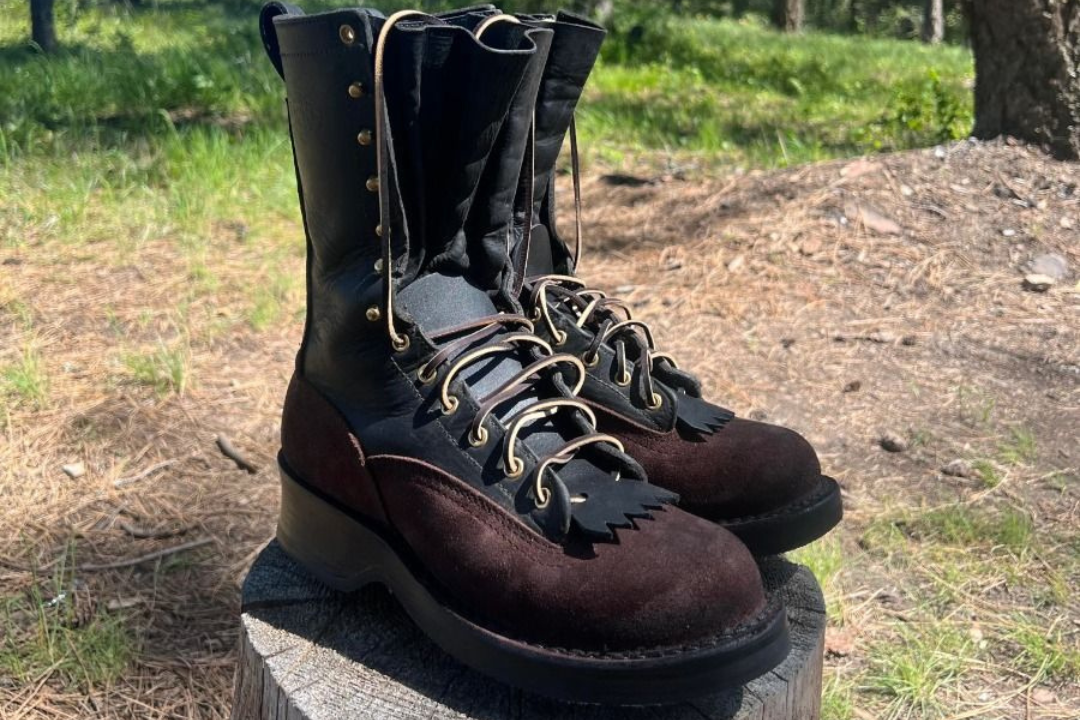
How to Choose the Right High-Quality Work Boot
Finding the right work boot is about more than just toughness—it’s about selecting a boot that fits your work environment, provides all-day comfort, and aligns with your specific needs. Let’s cover some things to keep in mind before you click checkout.
- Consider Your Work Environment: The setting you work in should determine the type of boot you need. If you work in construction, a steel-toe boot with a slip-resistant outsole offers vital protection on hazardous job sites. For ranchers and farmers, waterproof, breathable leather handles exposure to mud, dust, and fluctuating weather conditions.
- Prioritize Comfort and Fit: A proper fit from the start prevents fatigue, hotspots, and long-term discomfort. Full-grain leather gradually conforms to your foot’s shape, offering a custom fit that enhances wearability. Lace-up styles allow for better adjustability, while pull-on options provide convenience for those constantly on the move.
- Choose the Right Boot Height: Ankle protection is crucial in environments with uneven terrain or workplace hazards. Taller boots offer extra support for linemen, loggers, and outdoor workers, while a lower-profile boot provides flexibility for warehouse workers, delivery drivers, and mechanics.
- Match the Boot to Your Work Style: Whether you prefer the traditional look of a block heel and moc toe or require a technical build for high-impact tasks, your boots should represent your unique style and identity.
Read also:
- 8 Boots With Arch Support That Won’t Wreck Your Feet
- Top 5 Shoes Built to Alleviate Knee Pain During Long Workdays
- 5 Work Boots Built to Handle Wide Feet Comfortably
Frequently Asked Questions About High Quality Work Boots
Can work boots be waterproof and still breathable?
Yes, work boots can be both waterproof and breathable. At Nick’s Boots, we prioritize full-grain leather, which naturally offers water resistance while allowing your feet to breathe. This ensures that your boots keep you dry without feeling like a sauna.
Are steel toes necessary for all high-quality work boots?
Steel toes aren't necessary for all high-quality work boots, but they are essential for trades where foot protection from heavy objects or compression is crucial. Consider your specific needs and job requirements when deciding on steel toe boots.
Can work boots be resoled or refurbished?
Absolutely! One of the advantages of investing in high-quality work boots like those from Nick’s Boots is that they can often be resoled and refurbished. This helps extend the lifespan of your favorite boots and keeps them in top condition.
How can I tell if a boot has good arch support?
Good arch support is typically evident through the boot's design and insole quality. Look for work boots with well-crafted insoles or removable footbeds that provide cushioning and support. If in doubt, consult our team who can provide insights into which of our boots offer optimal arch support.
Can I use orthopedic inserts in my work boots?
Yes, you can use orthopedic inserts in your work boots to enhance comfort and support. Nick’s Boots are designed with sturdy interiors to accommodate such inserts, allowing you to tailor the fit and support to your liking.
What are the signs of a poorly constructed work boot?
Signs of a poorly constructed work boot include uneven stitching, thin or brittle leather, loose soles, and an uncomfortable fit even after a reasonable break-in period. Our commitment to quality craftsmanship ensures that you won’t encounter these issues in Nick’s Boots.
What safety features should I look for in work boots?
Key safety features to seek include reinforced toes (steel or composite), slip-resistant soles, and puncture-resistant outsoles. Additionally, ankle support and shock-absorbing heels are important for comfort and injury prevention.
What are the differences between men’s and women’s work boots?
Men’s and women’s work boots differ mainly in fit and sizing. Women’s boots are typically designed to accommodate a narrower foot and lower calf profile, whereas men’s boots cater to broader feet. At Nick’s Boots, we ensure both ranges offer the same level of durability and craftsmanship.
